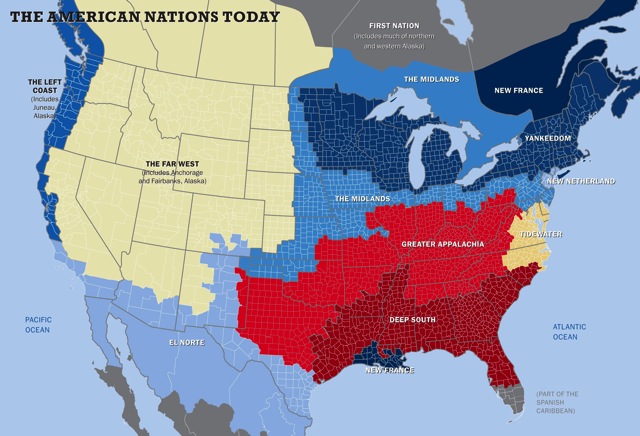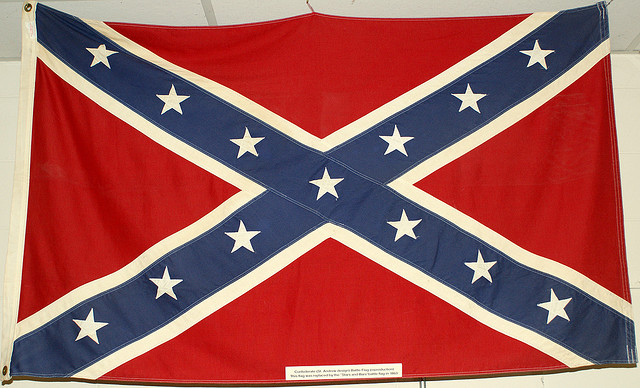Fascinating map and article here. People of Ulster descent will be found in pretty much all of these areas.

Always learning. Born, bred and still living on the most easterly point of Northern Ireland - the Ards Peninsula - 18 miles across the sea from Scotland. I do lots of things- design, music, talks, trying to be a husband and father. This blog isn't an example of great quality writing or research, it's just a scrapbook pointing towards content that's of interest. © the author; contact me for permissions
Fascinating map and article here. People of Ulster descent will be found in pretty much all of these areas.

As shown on the 1905 edition of this well-known volume which (significantly for the choice of cover image) was printed in Richmond, Virginia, the capital of the Confederacy from 1861–1865. Original Presbyterian Covenanter flags from the 1600s can be seen in many churches and museums in Scotland today, widely varying in design and iconography. Many have saltires, others have thistles and Bibles, one I have seen has Hebrew script. Usually they are tucked away in ante rooms, behind light-proof curtains and protective glass to help preserve them. Recent replicas often hang inside the main church buildings as a visible reminder of their Covenanting history.


'…Headin' down South to the land of the pines
Thumbin' my way into North Caroline…'
- from Wagon Wheel by Old Crow Medicine Show (and covered by countless others including Darius Rucker, above)
In recent weeks (due to the global reach of the media and the internet) the furore over the Confederate battle flag has reached Northern Ireland, where in at least one incident some moron(s) decided to fly it outside the home of a black family in East Belfast in an act of racist intimidation.
The furore has been sparked by the horrific slaughter of nine people at Emanuel African Methodist Episcopal Church in Charleston, South Carolina, by 21-year-old extremist Dylann Roof – who prior to the murders had posed with a collection of flags, one of which was the Confederate battle flag. Almost immediately a campaign against the use of the flag began, denouncing it as a racist emblem and a symbol of hate. That's the only reason it appeared a few days later in east Belfast. The murders had obvious echoes of the three murders in 1983 by a group operating under the name 'Catholic Reaction Force' (thought to be a cover name for the INLA) at Mountain Lodge Pentecostal Church in Darkley, South Armagh – a church I know and where my brother and I have played a few times. I have seen the bulletholes and have talked with scarred survivors. The forgiveness evident in both congregations is inspirational.
I've been to the Southern States on three occasions (first in 1997 on a 3 week honeymoon road trip) travelling through Virginia, Tennessee, Kentucky (a divided state during the Civil War), Georgia and the Carolinas. I bought various souvenir items, including various Confederate flags and imagery from roadside gift shops. I have a cousin in Alabama. Regular readers of this blog live all over the USA including the Southern States. I am no expert on the region, but I have talked with people in those states who treasure their regional heritage, their state's identity, their Confederate history, who feel very detached from Washington DC – and who are not in any way racist.
Prominent people across the US immediately began to call for the removal of the flag from public buildings, from private property, and even from the graves of Confederate war veterans. In one extreme case, the bones of a Confederate General Nathan Forrest were proposed to be exhumed from his grave in Memphis – an act reminiscent of the 'Killing Times' of 17th Century Scotland.
According to this article in The Economist, the population of the South is growing fast, so it can't be all that bad after all. It has also been long-observed that metropolitan America has made the rural South a scapegoat for generations, distracting from social problems elsewhere across the nation. This article, based on recent social media activity and Google searches, shows that racism is in no way confined to the South, or to former Confederate states. It's nationwide, North and South.
Here in Northern Ireland we understand the power of symbols and flags, but we (should) also know that the actions of an individual, a tiny minority, or even a terrorist/paramilitary organisation does not represent an entire community, region, country or nation. The mis-use or appropriation of the United Kingdom flag, the Northern Ireland flag or the Irish tricolour flag is a frequent occurrence here.
As in Northern Ireland, it is easy to create the appearance of 'action' by targetting symbols and imagery rather than dealing with the actual issues. A high profile political, media and PR campaign is easier to orchestrate than the hard work of actual change. A good explanation of the complexities of the whole story are well outlined here in an article entitled 'Scapegoating Symbols will not resolve Racial America'.
..............................

The Confederate and Charleston connection reminded me of an Ulsterman who claimed to have been present when the first shots of the American Civil War were fired, and who was present when the end of the War was agreed between the opposing Generals Lee and Sherman.
Colonel John Spencer Fairly (1832–1898) was born in Eglinton, County Londonderry. His father was Robert Fairly, the three-times Mayor of Derry in 1769, 1770 and 1782. Robert was son of David Fairly, Donnybrewer Lodge, whose father had been Rev David Fairly, the Presbyterian minister of Convoy and Raphoe for a reputed 65 years from 1711 – 1776). Colonel Fairly's mother was Sarah Huey (daughter of William Huey of Flowerfield House, near Muff just north of Londonderry).
Colonel Fairly said that he had been the commander of gun no. 3 in the remarkable floating "Iron Battery" on the attack on Fort Sumter on 13 April 1861, the first engagement of the Civil War (pictured above). However other sources say he enlisted six weeks later in June 1861 to a Captain Screven's company of horse. Promoted to lieutenant in November 1862, Fairly became aid-de-camp to General WHC Whiting, often acting as his scout. When Whiting was killed at Fort Fisher in March 1865, Fairly was reassigned to the staff of General Wade Hampton until the end of the war, eventually becoming lieutenant colonel. Fairly was present when General Hampton and General Robert E Lee met with General Sherman of the Union Army at Durham, North Carolina, when the three Generals signed the 'Memorandum of Agreement' on 18 April 1865 which effectively ended the war. (See here for a description of an inscribed revolver which was given to Fairly by General J. E. Johnston, on behalf of Hampton, that same day).

Fairly is known to have settled in Charleston after the war. He died at Wilmington, North Carolina, in August 1898, his obituary describing him as a 'gallant Confederate soldier" and "a prominent figure in the commercial life of Charleston, South Carolina", initially in wholesale, then railroads and also the production of cotton seed oil.
Fairly joined the Scotch-Irish Society of the USA in 1892, aged 60, 27 years after the end of the War. The claim of his involvement in the Iron Battery appears in his self-penned biographical notes. If true (and there's little reason to think he made up his story, which would have brought easy scrutiny and widespread ridicule) this places him at both the event which started the War and the event which ended the War. Founded in 1889, the Society's published Proceedings show a determined effort to acknowledge the wartime courage of the people of both North and South.
His brother, Lt. Col. William H Fairly, was a Confederate army courier and was killed at the Battle of Trevilian Station in Virginia. It was the largest all-cavalry battle of the war, taking place in June 1864.
I wonder how Fairly's Ulster Presbyterian family took the news that he had become Episcopalian! He was a member of St Philip's Episcopal Church in Charleston, a congregation which stood in solidarity with the city's grieving Emanuel AME Church in the aftermath of the Dylann Roof murders.
..............................
"People groups" are too simple. Not everyone who is a proud Southerner is a racist. It is far too simplistic, and possibly a grotesque smear, to suggest that everyone in any "people group" thinks and behaves the same way. Every nation's flag can be interpreted as either honourable or dishonourable. Men from every tradition in Ireland fought on both sides of the "War Between the States".
When in Kentucky in 1997 we stayed at Boone Tavern in the college town of Berea. The College was the first racially integrated educational establishment in the South, founded in 1855 by an Irishman and his Scotch-Irish wife. To this day, the motto of the College comes from the New Testament –
"And hath made of one blood all nations of men for to dwell on all the face of the earth" – Acts 17:26.
..............................
PS – If any readers know more about Fairly I would be delighted to hear from you. As this 1889 pamphlet shows, he was anti-slavery, but given his other theories therein I doubt very much that he was a paragon of virtue, or that his late 1800s attitudes will be consistent with ours in the present day. Nevertheless he seems like an interesting, but forgotten, figure.
His retail premises in Charleston are shown below.

American Reformed Baptist pastor Voddie Baucham is back in NI during August. Details on his website are sketchy just now – Belfast, Strandtown, Bangor, Enniskillen and also Letterkenny in Donegal. His background and personal story are available here, which includes postgrad study at Oxford. He has been in NI on a number of occasions before. He las lots of videos available online and, in an age when race is a dividing issue, preaches the Gospel for all people and to all people with power and vigour. The Gospel Coalition publish some of his articles here, and SermonAudio hosts a lot of his regular preaching here. He is due to relocate from the USA to Africa later this year